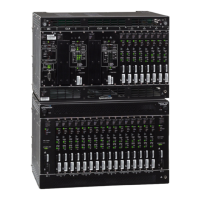24 097-55501-01 Issue 6 – June 2003
1
TimeHub 5500 System Guide
value can be assigned to each of the inputs. For all inputs, if the
SSMENB setting is "N" (see next comment), CURRSSM will simply
respond with the QLEVEL setting.
• The SSMENB (SSM Enable) keyword is used to tell the TimeHub
that this input should actually extract SSM information from the
input (as opposed to using the QLEVEL setting for the input).
When an input is enabled for actual SSM extraction, the extracted
value is retrieved using the CURRSSM keyword. Thus, CURRSSM
always returns the SSM quality level associated with the selected
input, regardless of whether this quality level is obtained from the
QLEVEL setting (SSMENB disabled) or from the input itself
(SSMENB enabled).
• With SSMENB enabled (meaning that SSM information is to be
extracted from that particular input), there are several situations to
consider:
- If no valid SSM value has yet been read on that input and the
input is qualified (otherwise determined to be usable as a timing
reference) its quality level will be reported as 2.
- If the SSM value is actually being read from the input, the qual-
ity level will be reported according to the extracted value. This
would be the normal situation for using this feature.
- If the SSM value has been read but then becomes no longer
readable for a period of about 10 seconds (even though the
input otherwise remains usable as a timing reference), the
reported quality level will be 255. This special value is used to
uniquely identify this situation. If SSM values subsequently
become readable, the actual SSM value will again be reported
via CURRSSM. If SSM remains unreadable, disabling and re-
enabling SSMENB will re-initialize the input to report a quality
level of 2, since this returns the input to the situation of no
valid SSM value has yet been read (same as first situation
above).
1.3.4.2 Using SSM to Determine the Active Timing Reference
It is possible to use the input SSM values for determination of which input
will be selected as the active timing reference. The SYNCMDE keyword
provides this control. There are four settings, one of them being "SSM".
When SSM is selected, the CURRSSM value is the primary decision-maker
for selecting the input to use (the input must be otherwise qualified for use
to be selected). Given that SYNCMDE has been set to SSM, there are several
considerations:
• The qualified input with the numerically lowest SSM quality level

